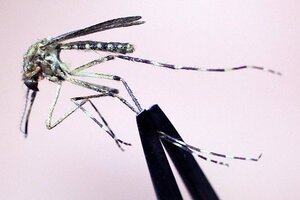Huge Florida mosquitoes: Monster insects are called 'Gallinippers'
Huge Florida mosquitoes the size of a quarter are set to invade Florida — if the rainy season is wet enough.

This perfectly ordinary mosquito is shown at high magnification. The huge mosquitoes poised to invade Florida are nearly this big without magnification — they're about 20 times larger than ordinary mosquitoes.
Pat Wellenbach/aP
One of the most ferocious insects you've ever heard of — it's the size of a quarter — is set to invade Florida this summer.
The Sunshine State, already home to man-eating sinkholes, invading Burmese pythons, swarming sharks, tropical storms and other disasters, can expect to see an explosion of shaggy-haired gallinippers (Psorophora ciliata), a type of giant mosquito, according to entomologist Phil Kaufman of the University of Florida.
Gallinipper eggs hatch after a rainstorm or flood, and the state saw a big jump in the numbers of gallinippers last summer after Tropical Storm Debby dumped its load on Florida. Eggs laid last year could produce a bumper crop of the blood-sucking bugs this summer if Florida sees a soggy rainy season.
"I wouldn't be surprised, given the numbers we saw last year," Kaufman said in a statement. "When we hit the rainy cycle, we may see that again."
As insects go, gallinippers are particularly formidable. Their eggs lay dormant for years, awaiting the floodwaters that will enable them to hatch. Even in their larval stage, gallinippers are so tough they'll eat tadpoles and other small aquatic prey.
And as adults, the voracious pests feed day and night (unlike everyday mosquitoes, which generally feed only at dawn and dusk). Their bodies are strong enough to bite through clothing, and they're known to go after pets, wild animals and even fish, MyFoxOrlando.com reports.
"It's about 20 times bigger than the sort of typical, Florida mosquito that you find," Anthony Pelaez of Tampa's Museum of Science and Industry told Fox Orlando. "And it's mean, and it goes after people, and it bites, and it hurts."
The term "gallinipper" isn't recognized by most entomologists, but over the past century, the word — and the insect — entered popular legend through Southern folktales, minstrel shows and blues songs, according to a report from the Institute of Food and Agricultural Sciences at the University of Florida.
The earliest description of the pest comes from 1897 by a writer who called the insect "the shyest, slyest, meanest and most venomous of them all." (Gallinipper bites don't actually contain any venom — they just feel that painful.)
Will insect repellents help to protect people from the dreaded gallinipper? Maybe, Kaufman said, though the pests may be more resistant to bug repellents — even those containing DEET — because of their large size.
If there's a silver lining to a possible invasion of gallinippers, it's the fact that their larvae are so ravenous they eat the larvae of other insects, including mosquitoes, thus reducing the populations of those pests. And they're not known to carry any diseases, though that may be small comfort to beleaguered Floridians.
Email Marc Lallanilla or follow him @MarcLallanilla. Follow us on Twitter @livescience, Facebook & Google+. Original article on LiveScience.com.
- Dazzling Photos of Dew-Covered Insects
- Microscopic Monsters: Gallery of Ugly Bugs
- In Photos: Top 10 Deadliest Animals
Copyright 2013 LiveScience, a TechMediaNetwork company. All rights reserved. This material may not be published, broadcast, rewritten or redistributed.

